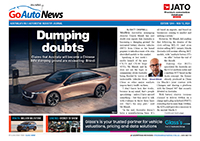Make / Model Search
News - General News - RegulationBi-modal mufflers under scrutinyMuffled tones: Bi-modal exhaust systems, available on a number of high-performance models including the Audi TT RS, will be more closely scrutinised under new government regulations. State authorities to test bi-modal exhaust systems in their loudest configurations23 Jun 2014 By IAN PORTER MOST current Holden Special Vehicle models and some Porsches will come under closer scrutiny by registration authorities when tighter regulations governing bi-modal exhaust systems are introduced by state governments. The systems allow the driver to change the exhaust note of the vehicle from normal to rorty with the flick of a switch, changing from a fully muffled system to a more open, free-flowing exhaust. HSV, Porsche and Audi are among the few manufacturers that offer bi-modal exhaust systems, although the new regulations will also apply to modified vehicles. The state and territory governments will be implementing the latest recommendations from the National Transport Commission, which acts to keep the Australian Design Rules up to date with technology changes. The NTC puts forward proposed legislation for adoption by all states and territories to ensure uniformity of regulation across the country. The change relating to bi-modal exhausts is also expected to apply to some some exotic European sportscars, such as the Aston Martin One-77 and many modified vehicles, particularly sportscars and hot rods that do double duty on the road and on the racetrack. Some Porsche models as well as the Audi TT RS also feature bi-modal systems. HSV is confident the six models in its range that feature bi-modal exhaust systems are all legal in their loudest configuration. “We comply with all models,” HSV marketing manager Damon Paull told GoAuto. National Transport Commission chief executive Paul Retter said the regulations will streamline the laws around the country. “The changes will prevent people getting around excessive noise rules with adjustable mufflers,” he said. Mr Retter said the present regulation states that a vehicle powered by an internal combustion engine must have a silencing device through which all the exhaust gas passes. A two-mode system does meet this requirement, but it can also get around it at the flick of a switch. The new regulation will compel state testing authorities to test such a system at its maximum noise level, not the minimum level, Mr Retter said. “The objective of the amendment is to prevent the manipulation of silencing devices which could be configured by means of in-vehicle controls to pass stationary noise tests,” he said. The current limits for passenger vehicle noise are 90dB for vehicles made after 1983 and 96dB for vehicles made before 1983. In a significant change for the fledgling electric bicycle sector, the commission will also ask that states legislate to make it clearer to enforcement authorities that bicycles with power assist should not be forced to be registered like a car or truck. The NTC has recommended that authorities raise the permissible power of electric bicycles from 200 watts to 250 watts and still leave them exempt from Australian Vehicle Standards Regulations (AVSRs). “We’ve also made changes so that it’s clear that particular push bikes with motors or power-assisted pedal cycles are not subject to AVSRs,” Mr Retter said. He said this would avoid unnecessary restrictions for riders. The recommendation follows a change made in the Australian Design Rules in 2012 that brought them into line with European regulations on pedal/electric bicycles. However, these “pedalecs” and their riders will still have to meet certain regulations. They will be restricted to a top speed of 25km/h and will have to meet a number of construction safety requirements. while riders will have to wear bicycle helmets. The NTC also rejected a call by the Victorian Motorcycle Council (VMC) to vary the window tinting rules as they apply to motorcycles. The NTC has ruled that all windows and partitions that are tinted must have a luminous transmittance of at least 70 per cent. The VMC had argued for an exemption on the basis that most motorcycle windscreens were primarily an aerodynamic and deflection device. The NTC decided that the enforcement of a rule differentiating between windscreens and wind deflectors would be extremely difficult to enforce.  |
Click to shareGeneral News articlesResearch General News Motor industry news |









Facebook Twitter Instagram